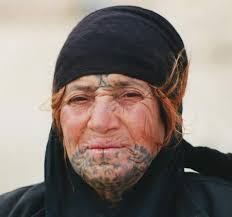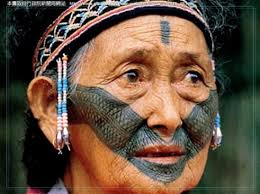When I was a child, my parents told me that only bikers and sailors had tattoos. While that is obviously no longer the case (if it ever was), I grew up thinking that tattoos were introduced to Europe in the 18th Century by sailors returning from voyages to the South Seas. While they may have revived this old custom in Europe, there is a long and varied history for this artistic medium that shows up on all continents and was only repressed in Europe by the rise of Christianity. I guess I should have known better, since they are outlawed in the Old Testament, but I somehow never put it all together. What follows is a cursory examination of the history of the medium.

Polynesian tattooing goes back over two thousand years. The artists would use a variety of bone combs and a mallet to imprint the design. The ink was made from the soot of burnt lama nuts. Styles varied from island to island, but all are believed to have significant cultural meaning. Some designs spoke of rank, while others described the attributes of the bearer, with the juxtaposition of symbols giving shades of meaning conceived by the artist. The art itself was usually passed down from a master to a single apprentice (often father to son) because of its spiritual nature. Tattooing was a very painful process with a fair risk of infection lasting ten days (for men), but to halt the process would lead to a lifetime of shame. The subject would go through a period of cleansing prior to the ceremony. Women were tattooed as well as men, but to a much lesser extent. Happily, some of these traditions have survived to the modern day.

In Persia (19th-20thC), it seems the barber could also give you a tattoo while you went in for your weekly bath. The earliest known work in the region is from a Scythian Chief of the 5th Century BCE. The most famous literary mention is found in Rumi, written some 800 years ago. At one time, slaves were tattooed or branded on the face with the initial of their owner. Men often got tattoos on the chest and arms emphasizing strength, while women's were usually on the head or neck to enhance their beauty (though some were temporary). Designs were also employed to cure persistent physical ailments, such as arthritis. Certain tattoos were thought to have magical properties: extending a child's life, keeping away the evil eye, or ensuring a husband's devotion. Tattoos are generally painted on first, then pricked in with a needle, before rubbing in the color. These might be done by gypsy women, the old guy at the gym (for wrestlers), or the local barber. This practice died out among most of the upper classes by 1900, but survived with nomads and villagers.

Taiwan has a tradition of facial tattooing amongst the Atayal people dating back 1,400 years. Tatooing is part of the ritual passage into adulthood. Men must prove themselves worthy though their ability to hunt (including headhunting) and women through weaving. This passage was a requirement prior to marriage. The technique is a sacred duty passed down from mother to daughter. It is done with a needle and the charcoal ash of pine trees, with the process taking around ten hours. With the arrival of Christianity, this custom has been all but eradicated with one couple receiving the tattoos in the last hundred years.

As you might expect in such an ancient culture, tattoos have gone through several waves of popularity and meaning in Japan. Tattooing is thought to go back some 10,000 years. The women of the indigenous Ainu people of Hokkaido tattooed their lips. They were at times used as symbols of status and spiritualism, while at other times they marked criminals (on the head or forearm) and prostitutes. The modern form developed in the Edo period (1600-1868) alongside the woodblock printing techniques, employing some of its tools. Some believe that elaborate tattoos became popular among the middle classes as a form of rebellion, because they were forbidden to wear the beautiful clothing of the gentry. Today, elaborate Japanese style tattoos are often frowned upon in Japan due to its association with organized crime.

Europe has its share of tattooed history as well. Ancient Rome started tattooing all of its new recruits with unit emblems on the left forearm and date of enlistment on the right wrist in the 4th Century BC. Slaves and criminals were also marked with tattoos in that time. Elite warriors of Germanic and Celtic tribes also used elaborate tattoos (and some say branding) of symbols or animals. The Scandinavian Rus Tribe was described by Ahmad ibn Fadlan in the 10th Century as having been, " tattooed from 'fingernails to neck' with dark blue 'tree patterns' and other 'figures.'" Even during the Crusades, warriors would get a tattoo of the Jerusalem cross to be ensured of a Christian burial if they died in combat. While it may not have been widely popular in Europe following the spread of Christianity, tattooing certainly persisted, especially among those who had contact with other cultures.
The relationship between people and tattoos has been tumultuous to say the least. Sometimes a beautification, sometimes a test of manhood, sometimes the mark of a criminal, we have been using these permanent markings to differentiate ourselves for a long time. One source cites a 7000 year old tattooed mummy found in Chile. There are far too many cultures who have employed them to explore in a single post, but I hope you have enjoyed this brief exploration. Wander the links below for loads more information.
http://www.apolynesiantattoo.com/polynesian-tattoo-history
http://www.avaikitatauart.com/interview.htm
http://www.iranicaonline.org/articles/kalkubi
http://www.persian-tattoo.com/history-of-persian-tattoo.html
http://www.vanishingtattoo.com/tattoo_museum/arab_tattoos.html
http://www.culture.tw/index.php?option=com_content&task=view&id=1370&Itemid=157
http://sangbleu.com/2013/12/14/ainus-womens-tattooed-lips/
http://www.iromegane.com/japan/culture/history-of-japanese-tattoo/
http://voices.yahoo.com/tattoos-ancient-europe-historical-look-via-archaeology-2492918.html
http://tattoosymbolism.blogspot.com/2012/03/celtic-knot-tattoo-symbolism.html
http://www.tribal-celtic-tattoo.com/celtic-history2.htm
http://tattoohistorian.com/
No comments:
Post a Comment